This is another patient of mine who underwent a subnasale upper lip lift procedure to shorten her upper lip. Like many patients seeking upper lip lift surgery, this young lady desired to have a more proportional upper lip in comparison with her surrounding lower facial features.
As you can see in her pre lip lift photographs, her upper lip, indeed, appears elongated. When analyzing the lower face (from just under the nose down to the chin), we normally divide it up into horizontal thirds. This can be seen in the adjacent photo diagram as indicated by the green markings divided into three horizontal sections. The first section goes from just under the nose (the subnasale) down to the junction of the upper and lower lip. The second section goes from this junction down to the mental crease (the depressed area of skin just above the chin). The third section goes from the mental crease down to the bottom of the chin. Ideally, these three horizontal sections are equal in height – so equal one-thirds. That being said, it is quite rare to see anyone that naturally has ideal proportions with equal one-thirds. But there are many patients, like this patient seeking a lip lift, where the first horizontal section is longer (or higher when looking at her from the front). In fact, the blue in the diagram shows the true distance of her upper one-third. As you can see, it is several millimeters longer than it ideally should be. Even several millimeters like this can be the difference between an esthetically pleasing upper lip and a lip that is excessively long. In this particular patient example, this excess upper lip length was bothersome and brought out the disproportion in her lower face region. Because of this, she decided to consult with my facial plastic surgery office for a possible upper lip lift.
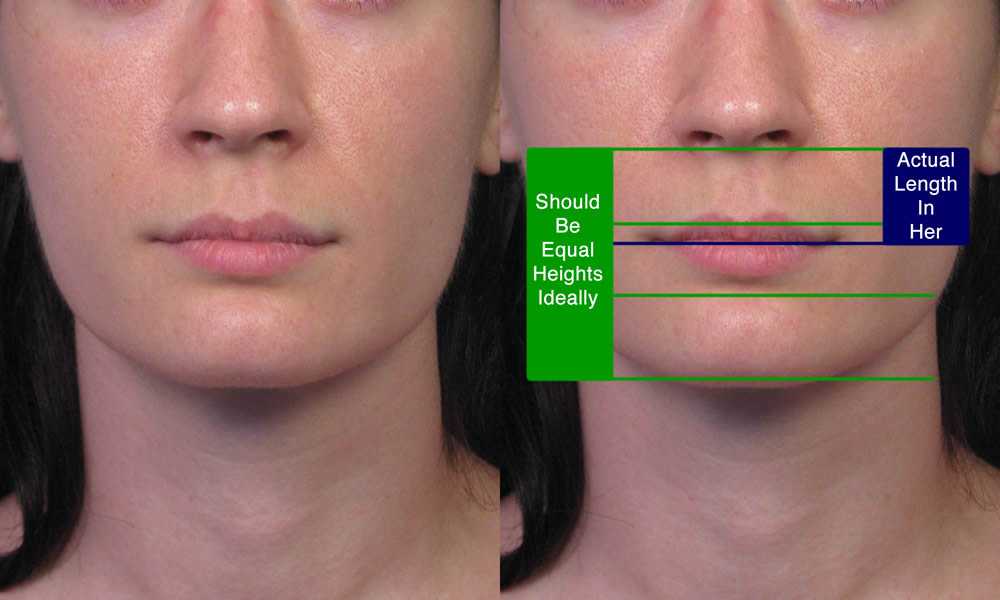
Other Considerations in Upper Lip Lift
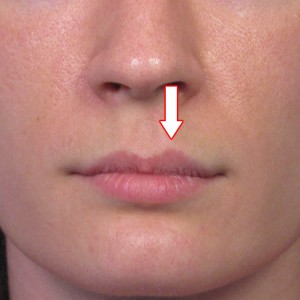 In addition to issues with excess length, many patients seeking upper lip lift surgery desire other changes to this region. For example, some patients also want a more volume-enhanced upper lip. By this, I am referring to the red (or pink) portion of the upper lip. It is generally thought that an upper lip that has more red (or pink) as seen from the different angles is more desirable, or esthetically pleasing. This typically goes hand in hand with a well-defined cupid’s bow where most lips that have good volume and red show also have a nicely shaped cupid’s bow.
In addition to issues with excess length, many patients seeking upper lip lift surgery desire other changes to this region. For example, some patients also want a more volume-enhanced upper lip. By this, I am referring to the red (or pink) portion of the upper lip. It is generally thought that an upper lip that has more red (or pink) as seen from the different angles is more desirable, or esthetically pleasing. This typically goes hand in hand with a well-defined cupid’s bow where most lips that have good volume and red show also have a nicely shaped cupid’s bow.
In addition, some lip lift patients would like to have more of a symmetrical shape to the upper lip. For instance, in this case example here, the patient’s upper lip is asymmetrically – which is much more the rule rather than the exception. You can see this in the adjacent photo diagram where the white arrow points out how her left upper lip arch is more pronounced versus her right side. In some cases of upper lip lift surgery, this can be improved in the process of shortening the upper lip.
Another consideration in upper lip lift surgery is dental show. This refers to visibility of the teeth, especially when one smiles. Many patients feel as if they have too little dental show when smiling and animating. In some cases, a subnasale upper lip lift can make it so there is more visibility of the teeth when smiling. Unfortunately, this does not happen in all cases and is more dependent on individual anatomy when it comes to shortening the upper lip.
Subnasale Upper Lip Lift
In this particular case example, a subnasale lip lift was performed for many of the indications noted above. Primarily, the procedure was being done to shorten her upper lip distance to create better balance. In addition, she did have the asymmetry with plans for improving this issue during the lip lift.
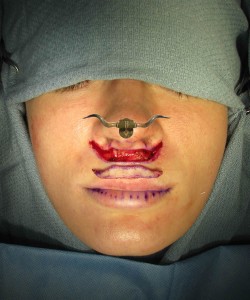 As in nearly all cases, I performed the lip lift with what is called a bullhorn incision. This is an incision (cut) that is made along the border of the bottom of the nose (where it junctions with the white portion of the upper lip). The photo diagram to the left visually demonstrates this incision. You can see from the superimposed bullhorn why the surgery is commonly referred to as a bullhorn lip lift procedure. The outline of the actual incision in the upper lip appears very similar to the shape of a bullhorn. In this particular case, you can see the see that has been removed from the upper lip. Underlying this area (the red tissue between the cut edges) is a portion of the orbicularis oris muscle – the oval shaped muscle that forms the opening of the mouth.
As in nearly all cases, I performed the lip lift with what is called a bullhorn incision. This is an incision (cut) that is made along the border of the bottom of the nose (where it junctions with the white portion of the upper lip). The photo diagram to the left visually demonstrates this incision. You can see from the superimposed bullhorn why the surgery is commonly referred to as a bullhorn lip lift procedure. The outline of the actual incision in the upper lip appears very similar to the shape of a bullhorn. In this particular case, you can see the see that has been removed from the upper lip. Underlying this area (the red tissue between the cut edges) is a portion of the orbicularis oris muscle – the oval shaped muscle that forms the opening of the mouth.
One of the few controversial topics in the world of upper lip lift surgery is whether or not this muscle should be cut at the time of the operation. In my humble opinion, I do not recommend cutting or hemming this muscle. I realize there are other plastic surgeons out there who do perform muscle tailoring (hemming) with lip lift surgery and achieve very nice surgical results. But I prefer not to cut or hem the muscle because of my concern with creating an abnormal smile after surgery.
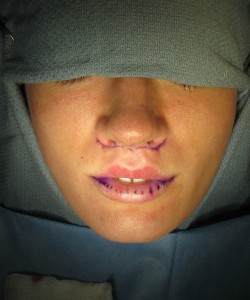
I have seen this type of outcome on occasion (from other plastic surgeons’ work) and would like to avoid it if possible. Since it is possible to attain very nice results without cutting the orbicularis oris muscle, I choose to avoid this maneuver. Instead, I lift the lip by placing several strategic sutures deep underneath the skin but above the muscle layer. In this manner I can lift the lip up and close the incision line with minimal tension. This is demonstrated here to the right. In this photo you can see how the bullhorn incision has now been closed and the upper lip has been lifted. You also see how there is some degree of dental show where her teeth are peaking out through her lips. The red (pink) lip is more visible now and the cupid’s bow is more defined. Symmetry from left to right is also better. Looking at these photos from her actual upper lip lift surgery, you can certainly see there is some degree of swelling and tissue distortion. This is fairly normal for this type of upper lip enhancement surgery.
Recovery From Upper Lip Lift Surgery
Recovery from upper lip lift surgery using the subnasale (bullhorn) incision approach can take upwards of 7-10 days before the initial swelling settles down. Keep in mind that within the first few days there can be a moderate amount of swelling involving the upper lip to where it even looks quite concerning in some cases. Usually 72 hours is the point of maximal swelling before it begins to decrease. Thereafter, the swelling typically resolves in a timely manner.
Scars from the incision will take upwards of a full year to fully heal, but the upper lip really begins to look pretty good within a few weeks. Nowadays, most patients will begin using a topical silicone gel on the incision line to help promote better scarring. Sun precautions are also very important for the entire first year of healing to minimize chances of abnormal pigment and excess redness.
Before and After Upper Lip Lift Surgery
These photos here show this patient before and after subnasale upper lip lift surgery using the bullhorn incision approach and no muscle hemming. As you can see, her upper lip has been shortened very nicely without leaving her looking surgically done. Her incision (scar) hides very nicely along the junction of her nose and upper lip with minimal visibility as seen here. Her red (pink) lip has more show with a more feminine looking and defined cupid’s bow. Additionally, her upper lip is now more symmetrical when comparing the left and right. Overall, this patient is quite happy with her upper lip lift surgical result.
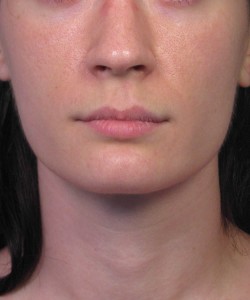
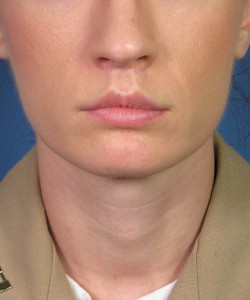
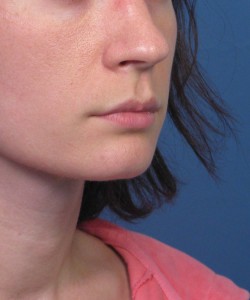
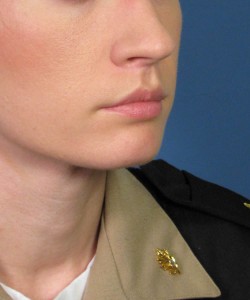
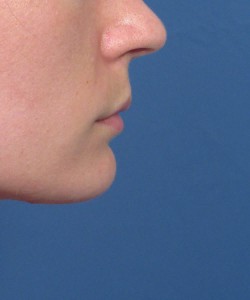
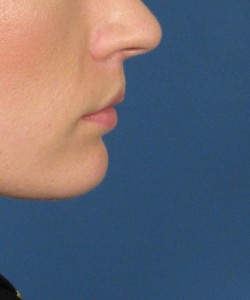
Subnasale Upper Lip Lift Consult
If you are considering upper lip lift surgery, feel free to contact our office today. We happen to be one of the few practices in this region of the United States that offers this very niche procedure to patients with an elongated upper lip.
Do you have additional questions?
Visit our frequently asked questions or contact our office to schedule a consultation.
FAQs Contact UsDr. John Hilinski has either authored or reviewed and approved this content.



